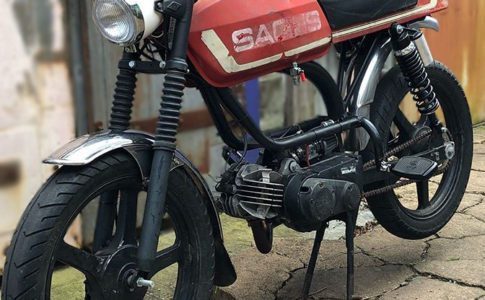I’m working on getting this Safari Turbo back on the road. It’s complete but doesn’t run. Let’s get this Safari Turbo Moped going.
Part one of getting this Safari moped back on the road. Let’s start by checking for spark and compression. First, I tried seeing if I could get it to spark with how it was sitting. No luck, so I broke out my alligator clip wires. I take my wires and make sure the blue wire from the ignition is connected to the ground. Next, I check that the kill switch is set to “run.” I try again with no luck.
Then I removed the external ignition coil, plug, and boot that came with the bike. I remove any loose wiring in the way. The plan is to simplify the wiring to just what is needed to generate a spark. I use my alligator clip wires to hook up my testing equipment to the moped. An external ignition coil with a condenser attached is what I use when troubleshooting ignition issues. I pair that with a good spark plug and spark plug boot. This way, I can rule out a bad spark plug, ignition coil, and condenser when testing for a spark.
I clean the surface of the head with a wire brush. This will be what I use as the ground. After testing, I’ll locate a better ground when it’s time to clean up the wiring. I hooked all of that up and tested for spark again. No luck there, either. So I get my continuity tester out and make sure I’m getting a good connection with all the wiring I’m using for troubleshooting. After that, I remove the fan cover and fan to check if the points are opening and closing. I adjust the point gap and try again. No luck.
I remove the flywheel and take a look for any damage or corrosion. Everything looked good, so I tested the ignition with the continuity tester. The continuity tester has a small light that will turn on when the circuit is complete. If there is a break in the circuit, it will not light up. Closed points will cause the tester to light up. When the points open, the tester light should be off. The light stayed on as I rotated the flywheel. Which means the points are not opening. The points need to open around top-dead-center to generate a spark.
I test and adjust the points until I get the continuity tester light to turn on and off while the flywheel spins. Once it does that, I know the points are opening and closing as they should and when they should. I check that my spark plug boot and cable from the ignition coil pack are not loose. This way, I rule out a loose connection in those locations. Next, I connect my external ignition coil and turn the flywheel using a drill to test for spark. I run the drill for a while. My theory for this is to charge up the condenser. Once I get a spark with my test equipment. I hooked up the original equipment and tested for spark again.
If I didn’t get a spark, I would then start to test the external ignition coil. Then, the spark plug, followed by the plug wire and boot. Lastly, the internal condenser. Luckily, the issue was the points not opening. All of the other ignition equipment is working, and the bike has a spark now. I also adjusted the timing while I was troubleshooting. Lastly, I did a little finger compression test.
If you have any questions comment below and I will respond, or feel free to email at [email protected].




No comments